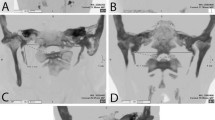Abstract
Background
To assess the variations of stylohyoid chain (SHC) using 3D-CT.
Methods
We evaluated a total of 200 SHC on the head/neck CT scans of 100 patients (44 females, 56 males, age range 18–73 years). All of the patients had been scanned for neck lesions other than those concerning the region of the SHC. The morphology of both SHCs was examined in the 3D-CT images and the following aspects were evaluated; 1. length, 2. thickness, 3. mediolateral angling (MLA), 4. anteroposterior angling (APA), and 5. bending of the SHC.
Results
Absence of the styloid process (n: 5), double proximal origin (n: 2), segmentation (n: 49), and complete ossification (n: 2) were found. The length of the SHC was 27.9 ± 11.3 mm, and 26.2 ± 11.1 mm on the right and left, respectively. The mean thickness of the SHC was 5 mm, and it showed positive correlation with length (P < 0.05). MLA was 73.2 ± 6.7 and 70.7° ± 8.0° for the right and left, respectively. APA was 64.6° ± 10.1° and 62.7° ± 10.2° for the right and left, respectively. There was a negative correlation between the right and left MLA (P = 0.001), and a positive correlation between the right and left APA (P = 0.001). Nine SHCs had bending of the lower end.
Conclusion
Three-dimensional CT gives detailed and reliable information about the SHC. We propose that the bending and thickness, which are new parameters, should be taken into consideration in the CT evaluation and classification of SHC variations.








Similar content being viewed by others
References
Basekim C, Mutlu H, Gungor A, Silit E, Pekkafali Z, Kutlay M, Colak A, Ozturk E, Kızılkaya E (2005) Evaluation of styloid process by three dimensional computed tomography. Eur Radiol 15:134–139
Camarda AJ, Deschamps C, Forest D (1989) I.Stylohyoid chain ossification: a discussion of etiology. Oral Surg Oral Med Oral Pathol 67:508–514
Gözil R, Yener N, Çalgüner E, Araç M, Tunç E, Çelioğlu M (2001) Morphological characteristics of styloid process evaluated by computerized axial tomography. Ann Anat 183:527–535
Krennmair G, Piehslinger E (2003) Variants of ossification in the stylohyoid chain. Cranio 21:31–37
Murtagh RD, Caracciolo J, Fernandez G (2001) CT findings associated with Eagle syndrome. AJNR 22:1401–1402
Onbaş O, Kantarcı M, Karasen RM, Durur I, Basekim CC, Alpera F, Okura A (2005) Angulation, length, and morphology of the styloid process o the temporal bone analyzed by multidetector computed tomography. Acta Radiol 8:881–886
Prasad KC, Kamath MP, Reddy KJM, Raju K, Agarwal SA (2002) Elongated styloid process (Eagle’s syndrome): A clinical study. J Oral Maxillofac Surg 60:171–175
Satyapal KS, Kalideen JM (2000) Bilateral styloid chain ossification. Surg Radiol Anat 22:211–212
Uysal Ramadan S, Gökharman D, Kacar M, Koşar U (2007) Complete ossification of stylohyoid chain. Diagn Interv Radiol (in press)
Author information
Authors and Affiliations
Corresponding author
Rights and permissions
About this article
Cite this article
Ramadan, S.U., Gokharman, D., Tunçbilek, I. et al. Assessment of the stylohoid chain by 3D-CT. Surg Radiol Anat 29, 583–588 (2007). https://doi.org/10.1007/s00276-007-0239-8
Received:
Accepted:
Published:
Issue Date:
DOI: https://doi.org/10.1007/s00276-007-0239-8




